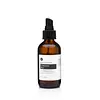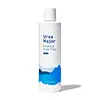What's inside
What's inside
 Key Ingredients
Key Ingredients

 Benefits
Benefits

 Concerns
Concerns

 Ingredients Side-by-side
Ingredients Side-by-side

Camellia Sinensis Leaf
PerfumingAloe Barbadensis Leaf Juice
Skin ConditioningLeuconostoc/Radish Root Ferment Filtrate
AntimicrobialGlycyrrhiza Glabra Root Extract
BleachingBeta-Glucan
Skin ConditioningGlucosamine
Niacinamide
SmoothingPanthenol
Skin ConditioningLactobacillus Ferment
Skin ConditioningLac Extract
Skin ConditioningLavandula Angustifolia Oil
MaskingDaucus Carota Sativa Seed Oil
EmollientCurcuma Xanthorrhiza Root Extract
Helichrysum Italicum Flower Oil
MaskingBoswellia Carterii Oil
MaskingCamellia Sinensis Leaf, Aloe Barbadensis Leaf Juice, Leuconostoc/Radish Root Ferment Filtrate, Glycyrrhiza Glabra Root Extract, Beta-Glucan, Glucosamine, Niacinamide, Panthenol, Lactobacillus Ferment, Lac Extract, Lavandula Angustifolia Oil, Daucus Carota Sativa Seed Oil, Curcuma Xanthorrhiza Root Extract, Helichrysum Italicum Flower Oil, Boswellia Carterii Oil
Aloe Barbadensis Leaf Juice
Skin ConditioningWater
Skin ConditioningHamamelis Virginiana Water
AstringentSalix Nigra Bark Extract
Skin ProtectingLeuconostoc/Radish Root Ferment Filtrate
AntimicrobialRosmarinus Officinalis Leaf
Skin ConditioningSodium Hyaluronate
HumectantGlycerin
HumectantLevulinic Acid
PerfumingSodium Levulinate
Skin ConditioningVaccinium Myrtillus Fruit/Leaf Extract
AstringentSaccharum Officinarum Extract
MoisturisingAcer Saccharum Extract
Skin ConditioningCitrus Aurantium Dulcis Fruit Extract
MaskingCitrus Limon Fruit Extract
MaskingOryza Sativa Extract
AbsorbentCamellia Sinensis Leaf Extract
AntimicrobialBetula Pendula Sap
Skin ConditioningLactobacillus/Arundinaria Gigantea Ferment Filtrate
Skin ConditioningCaprylyl/Capryl Wheat Bran/Straw Glycosides
CleansingFusel Wheat Bran/Straw Glycosides
EmulsifyingPolyglyceryl-5 Oleate
EmulsifyingSodium Cocoyl Glutamate
CleansingGlyceryl Caprylate
EmollientOlea Europaea Leaf Extract
PerfumingPseudotsuga Menziesii Branch/Leaf Oil
PerfumingLavandula Angustifolia Flower Oil
MaskingRosmarinus Officinalis Leaf Oil
MaskingPelargonium Graveolens Flower Oil
MaskingBoswellia Carterii Resin Extract
MaskingAlcohol Denat.
AntimicrobialAloe Barbadensis Leaf Juice, Water, Hamamelis Virginiana Water, Salix Nigra Bark Extract, Leuconostoc/Radish Root Ferment Filtrate, Rosmarinus Officinalis Leaf, Sodium Hyaluronate, Glycerin, Levulinic Acid, Sodium Levulinate, Vaccinium Myrtillus Fruit/Leaf Extract, Saccharum Officinarum Extract, Acer Saccharum Extract, Citrus Aurantium Dulcis Fruit Extract, Citrus Limon Fruit Extract, Oryza Sativa Extract, Camellia Sinensis Leaf Extract, Betula Pendula Sap, Lactobacillus/Arundinaria Gigantea Ferment Filtrate, Caprylyl/Capryl Wheat Bran/Straw Glycosides, Fusel Wheat Bran/Straw Glycosides, Polyglyceryl-5 Oleate, Sodium Cocoyl Glutamate, Glyceryl Caprylate, Olea Europaea Leaf Extract, Pseudotsuga Menziesii Branch/Leaf Oil, Lavandula Angustifolia Flower Oil, Rosmarinus Officinalis Leaf Oil, Pelargonium Graveolens Flower Oil, Boswellia Carterii Resin Extract, Alcohol Denat.
Ingredients Explained
These ingredients are found in both products.
Ingredients higher up in an ingredient list are typically present in a larger amount.
Aloe Barbadensis Leaf Juice comes from leaves of the aloe plant. Aloe Barbadensis Leaf Juice is best known for helping to soothe sunburns. It is also anti-inflammatory, moisturizing, antiseptic, and can help heal wounds.
Aloe is packed with good stuff including Vitamins A, C, and E. These vitamins are antioxidants, which help fight free-radicals and the damage they may cause. Free-radicals are molecules that may damage your skin cells, such as pollution.
Aloe Barbadensis Leaf Juice also contains sugars. These sugars come in the form of monosaccharides and polysaccharides, folic acid, and choline. These sugars are able to help bind moisture to skin.
It also contains minerals such as calcium, 12 anthraquinones, fatty acids, amino acids, and Vitamin B12.
Learn more about Aloe Barbadensis Leaf JuiceLeuconostoc/Radish Root Ferment Filtrate is a natural preservative. It comes from fermenting radish roots with a bacteria called leuconostoc.
Leuconostoc comes from lactic acid.
This ingredient has antimicrobial properties and helps prevent the growth of bacteria in a product.
Leuconostoc is used to make the traditional Korean side-dish, kimchi. It is also used to make sourdough bread (both incredibly yummy foods).
Learn more about Leuconostoc/Radish Root Ferment Filtrate